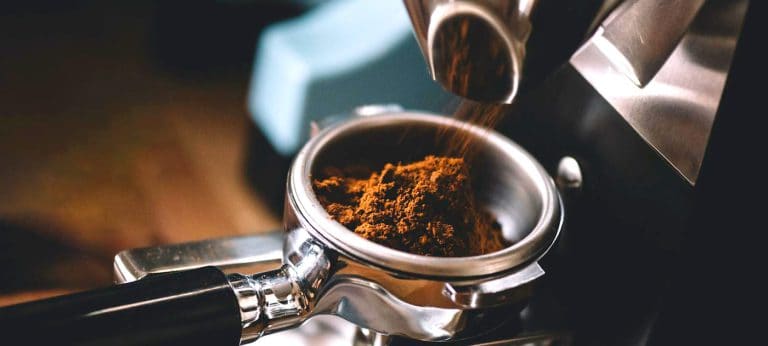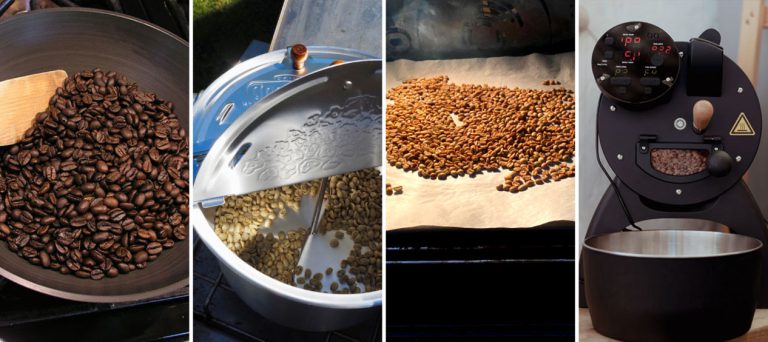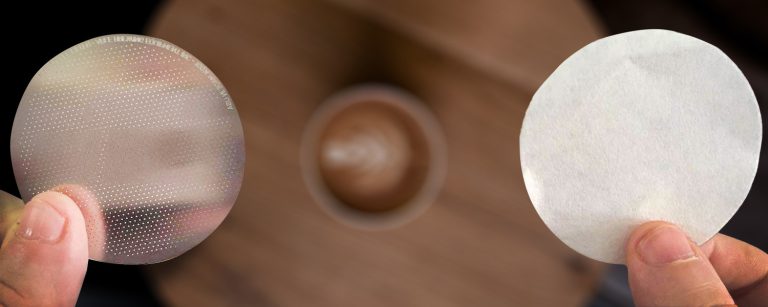35 Fun Coffee Facts to Perk You Up Like Caffeine
If you’re really passionate about coffee, don’t limit your knowledge about this world-famous drink to sourcing, brewing, and tasting.
During my coffee breaks, I’ve made it a habit to discover more about my favorite beverage and it made me realize how fascinating the world of coffee really is.
Today, I’ll share some of my favorite fun coffee facts that will open your eyes to how interesting this drink really is.
Ready your mugs and let’s get started.
1. According to legend, a goat herder discovered coffee.
Coffee’s history can be traced back to Ethiopia where it’s believed to have been discovered by a goat herder.
The story goes that this goat herder named Kaldi noticed that his goats were too energetic and didn’t sleep at night after eating berries from a certain tree. The townsfolk began talking and the word about these berries started spreading, kicking off the journey of coffee across the world.
2. Coffee comes from the word “qahwa” which means “wine.”
From Ethiopia, the coffee plant reached Yemen where it was then first cultivated. Yemenis spoke Arabic and called the brew “qahwa”, which originally meant wine.
As coffee spread to the Turkish Ottoman empire, they called it “kahve”.
From there, the Dutch started using using the word “koffie”, which is where the English “coffee” originated.
3. There were 5 attempts to ban coffee in history.
Coffee is a drink appreciated around the world, but did you know that there were multiple attempts across history to ban your favorite cup of joe?
It was banned in Mecca in 1511 because it stimulated radical thinking. In 16th-century Italy, clergymen claimed coffee was satanic, but the Pope didn’t agree. Other attempts to ban it happened in Constantinople in 1623, Sweden in 1746, and Prussia in 1777.
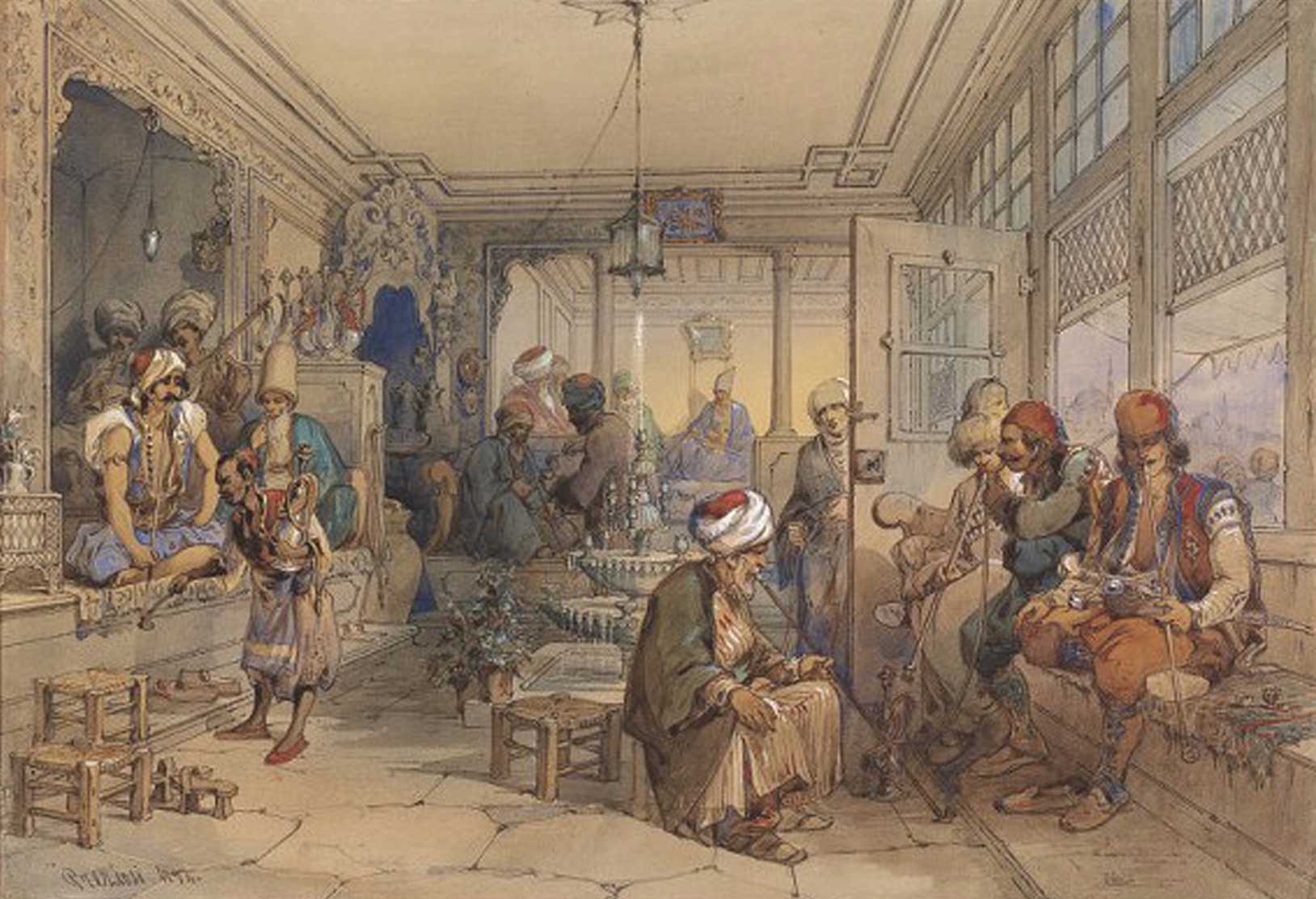
4. Drinking coffee meant death for some people.
When Murad IV of the Ottoman Empire banned coffee in 1623, you would have to take a beating if you were caught drinking it.
For a second offense, you will be put inside a leather bag and thrown into the waters of the Bosporus. Not worth it.
5. People used to eat coffee.
Today, we indulge in liquid coffee and sometimes infuse it in food like how espresso powder is used for baking or how it goes into a tiramisu.
But before its consumption was refined, coffee beans were ground into a paste and rolled with animal fat. These were eaten by African warriors to boost their energy before a battle.
6. Coffee can be harvested from cat poop.
One of the most expensive coffees in the world comes from coffee beans defecated by the Asian palm civet.
Kopi Luwak, aka cat poop coffee (although civets aren’t actually cats), is an Indonesian coffee that uses beans harvested from civet feces. The digestion ferments the coffee beans before they’re washed, disinfected, and roasted before brewing.
Is it worth $600 per pound?
7. The most expensive coffee in the world comes from elephant dung.
Similar to Kopi Luwak, Black Ivory coffee also comes from manure but in this case, from elephants.
Considered the most expensive coffee in the world, Black Ivory coffee from Thailand passes through the digestive tract of elephants, where it is fermented to naturally reduce its bitterness.
8. “Cup of joe” is believed to have been coined during WWI.
There isn’t any concrete history as to why coffee is called a cup of joe. One popular theory suggests that during World War 1, Navy Secretary Josephus Daniels outlawed alcohol on naval bases, so coffee was the strongest drink accessible to sailors. As an insult, it was called “cup of Joseph” or “cup of joe” for short.
Another theory suggests that it simply meant the average man, as in “the average Joe,” pertaining to how coffee is a drink popular to the common working-class man.
9. Coffee beans are actually seeds.
Some people will imagine coffee beans alongside your typical green beans. While coffee beans got their name from resembling such beans, they are actually seeds.
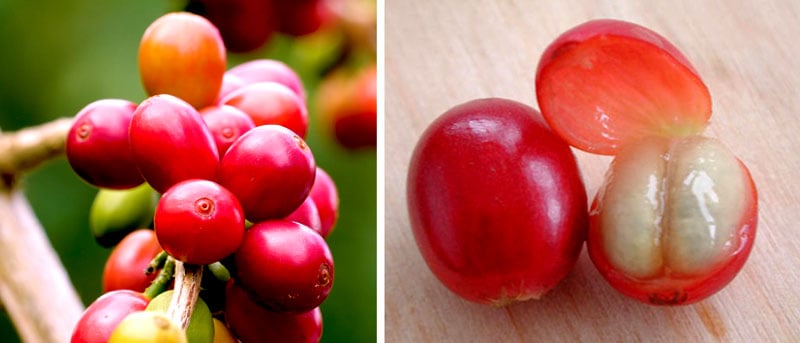
Unlike your usual legumes that grow from pods, coffee beans are seeds or pits from a coffee fruit.
10. Coffee trees take 3 to 4 years to bear fruit.
So how long do farmers wait to reap the fruits of newly planted coffee trees? It takes 3 to 4 years for the plant to mature enough to bear fruit.
After that, coffee trees have one major harvest every year. The harvest period differs by region.
11. Coffee cherries are edible.
If you’re wondering, coffee cherries can be eaten too. If you get the chance to taste one, you can expect a nice sweetness from the fruit’s flesh.
The thing is, unlike your typical fruits and berries, coffee cherries are mostly seed and tough skin with very little flesh in between so you’ll hardly enjoy it.
12. The coffee trees can live for up to 100 years.
A coffee tree can grow up to more than 30 feet and live for up to a century. It’s usually most productive though when it’s 7 to 20 years old.
Depending on the variety and how they’re maintained, coffee trees can also increase their yield over the years.

13. A single coffee tree produces less than a kilo of coffee beans in one year.
It will surprise you how many coffee trees are needed to keep the world caffeinated.
- In a year, a single coffee tree produces an average of 4.5kg (10 pounds) of coffee cherries in a year.
- From 4.5kg of coffee cherries, one can extract 0.8kg (2 pounds) of raw coffee beans.
Just take note that this yield can vary per tree.
14. Your 6 oz cup of coffee is made from 76 coffee beans.
To make your 6 oz cup of coffee, you use about 76 coffee beans. This is with the usual 10g of coffee grounds per 6oz cup and an assumption of the usual 0.13g per bean (although they can range from 0.12g to 0.17g).
Talking espresso, a single shot that uses 7g of coffee will use 54 coffee beans while a double shot uses 108 beans.
15. The largest cup of coffee in the world had about 27,000 liters of java in it.
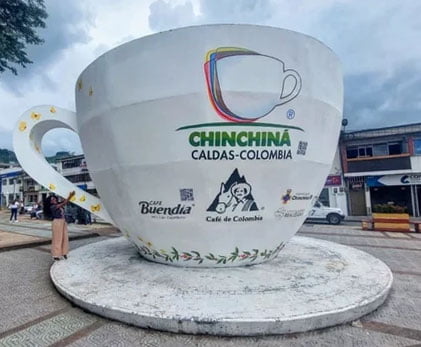
In December 2022, Mexico broke the world record for fixing the largest cup of joe. It contained 26,939 liters (910,915 oz) of coffee.
If you put that much coffee into 6 oz-sized cups, that’s 151,819 cups in total.
16. Decaf coffee doesn’t have “zero” caffeine.
Some people think that their cup of decaffeinated coffee is free of caffeine. In truth, the processes involved in cutting down the caffeine in coffee can leave an average of 7g of caffeine in your 8oz decaf.
Unless your tolerance for caffeine is very low, 7g is nothing to worry about compared to regular coffee’s caffeine content which ranges from 70g to 140g per cup.
17. Coffee has no calories (almost).
Your plain cup of joe contains almost zero calories. Two calories per cup, if you want to be specific. This is why you need not worry even if you’re on the strictest diet.
Just keep in mind that additions like milk, sugar, and other flavorings will inevitably crank up your cup’s calorie count. In fact, a 16oz cup of Starbucks’ Caffe Latte has 160 calories in it.
18. Cappuccino was named after friars.
Cappuccino is one of the most popular specialty coffee but unlike caffe macchiato and caffe latte, its name isn’t directly linked to coffee.

This drink got its name from Capuchin friars, whose robes had the same color as the coffee drink has, hence cappuccino.
And if you’re wondering how to make one, here is the simplest cappuccino recipe you’ll need.
19. The lack of coffee can be grounds for divorce.
Coffee has become an integral part of Turkish culture, even in marriage. During the Ottoman Empire, a factor of a woman’s ability to brew coffee is a factor in her fitness to be a wife.
On the flip side, a woman is said to have the right to divorce her husband if he can’t provide her with a daily cup of joe.
The lack of coffee can be grounds for divorce in some cultures.
bigcupofcoffee.com
20. Espresso isn’t derived from “express”.
The word espresso would make you think that it was derived from “express” which is only fitting given that this type of coffee can be brewed in seconds.
However, the Italian term caffe espresso literally translates to “pressed-out coffee” which refers to the way it forces hot water into the coffee grounds during brewing.
21. Coffee ranks second as the most consumed drink in the world.
If you still doubt how much coffee means to the world, it comes second to water as the most popular drink globally.
In a year, the world drinks an average of 400 billion cups of coffee. Check out my roundup of coffee consumption statistics for more insightful numbers.
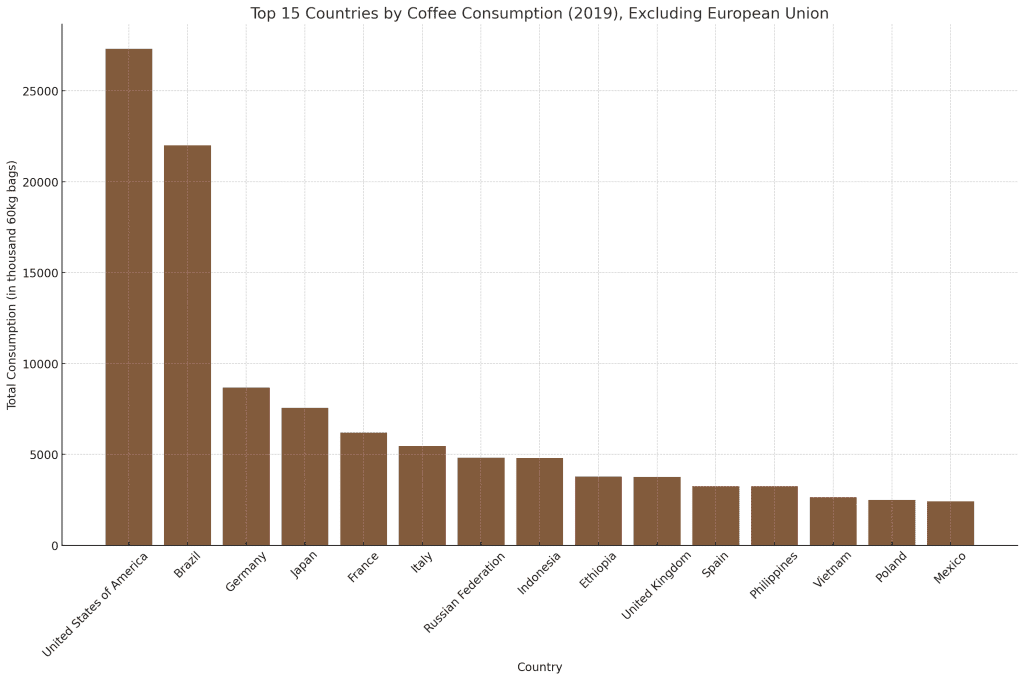
22. The USA drinks a lot of coffee, leading the ranking of consumers.
In the world, the USA is the biggest coffee consumer of coffee with up to 27 million 60kg bags of coffee consumed in 2019 alone. Data from 2022 also showed that 66% of Americans drink coffee every day.
Following the US as the world’s top drinkers are Brazil (22 million bags), Germany (8.67 million bags), and Japan (7.5 million bags).
23. Brazil produces 1/3 of the world’s coffee.
A third of all coffee produced in the world comes from Brazil, which has been the world’s biggest coffee producer for over 150 years now.
To put this into figures, the country can be credited for over 50 million 60kg bags of coffee every year. Read more on my list of the biggest coffee-producing countries.
24. Drinking 50 cups of coffee can be lethal.
Although it can vary from person to person, 10 grams of caffeine leads to a lethal overdose. Considering there are 100 to 200 grams of coffee in a cup, that would take at least 50 cups of coffee to take effect.
While this seems unlikely to happen, remember that there are more concentrated forms of caffeine out there such as caffeine powders and tablets. As a rule of thumb, keep your consumption to 400mg of caffeine per day as the FDA suggests.
25. Coffee can prolong your life.
Studies suggest that coffee that coffee can help you live longer. Figures show that coffee brewed from ground beans lowered the risk of death by 27%, followed by 14% for decaf, and 11% for instant coffee.
After all, coffee is known for preventing and reducing risks of heart disease, depression, diabetes, and certain cancers.

26. The term “java” comes from an island.
Another well-known term for coffee is “java” which comes from the island of Java in Indonesia. Java is the main island where the country’s capital Jakarta (formerly Batavia) is located and where the majority of the coffee exports come from.
While it has become a general term, Java coffee is also a specific type of Arabica that’s grown and processed on the island.
27. Some countries drink coffee with raw eggs and butter.
Some unusual additions to coffee are eggs and butter. Egg coffee is a Vietnamese coffee drink topped with a foamy mixture of egg yolk and condensed milk.
Meanwhile, butter coffee or bulletproof coffee is a popular keto drink that combines your favorite cup of joe with butter and MCT fats or coconut oil.
28. Two US states grow coffee.
The United States has two states that grow coffee, which are Hawaii and Puerto Rico.
While not the top producers, both states are known for the quality of their yield; especially Hawaii’s Kona coffee. In the 2021-22 season, Hawaii’s total production was valued at $61.9 million.
29. We dispose of 2.5 billion coffee cups in a year.
With such a huge impact on the world, coffee also leaves a big carbon footprint. There are 2.5 billion coffee cups that go to the trash every year, while half a million tons of ground coffee waste go to landfills.
More the reason to choose sustainable products and practices for our daily cup of coffee.
What are you doing about it?
We dispose of 2.5 billion coffee cups in a year… What are YOU doing about it?
BigCupOfCoffee.com
30. Coffee grounds can be used as fuel.
Coffee fuels us every day, but it can also fuel vehicles. In London, Bio-bean turns 7,000 tons of used coffee grounds into biofuels.
In their estimate, such fuels can reduce greenhouse gas emissions by 80% compared to using carbon-based fuels.
31. The largest coffee shop in the world is in South Korea.
Positive Space 566 in South Korea holds the Guinness World Record for the biggest coffee shop. Located in Gyeonggi-do province, this coffee shop was inaugurated in September 2022.
This coffee shop can seat 2,190 people with its 4 floors and a total leasable gross area of 6,061.59 square meters.
32. Starbucks has about 35,711 coffee shops around the world.

In 2022, the world’s largest coffee chain has 35,711 branches operating around the globe. There were 19,838 international branches and 15,873 chains in the US.
That same year, Starbucks had its highest recorded revenue of $26.57 billion.
33. Bees also “drink” coffee.
The main pollinators of coffee plants are bees, and during this process, the bees are exposed to the caffeine in the flowers they pollinate.
Research found that caffeine enhances the memory of bees, which helps them get the job done more efficiently— just like us!
34. Drinking coffee too early in the morning isn’t too effective.
While it’s tempting to start your day right away with a cup of coffee, it’s better to hold off your java until mid to late morning. Click to read the details on why.

In short, during the early morning, your body is still high on cortisol, a stress hormone that keeps you alert. Adding caffeine to your system at this time will not be as effective as drinking coffee a few hours later after your cortisol levels have dropped.
35. Coffee sent athletes to the Olympics.
In 1932, the government of Brazil didn’t have enough money to fund their athletes for the Olympics. They found the solution through coffee.
The athletes shared their ship with a cargo of coffee, including donated beans from coffee growers, and these coffee beans were sold at ports along the way. What a way for coffee to save the day.
Conclusion
There you go— a list of interesting facts about coffee that shows this caffeinated drink’s rich history, its role in many cultures, and its big impact on the world. Just goes to show you how the changing coffee industry always has something new to explore.
Share these interesting coffee facts with your friends right now, they will thank you 🙂
35 Fun Facts About Coffee to Perk You Up Like Caffeine
BigCupOfCoffee.com
Sources:
- ncausa.org/about-coffee/history-of-coffee
- ncausa.org/About-Coffee/What-is-Coffee
- bbc.com/news/magazine-22190802
- nationalcoffee.blog/2015/12/15/5-attempts-to-ban-coffee-in-history/
- starbucks.com.au/post/74/the-history-of-coffee
- npr.org/sections/thesalt/2014/08/20/340154271/
- merriam-webster.com/wordplay/where-do-we-get-cappuccino-from
- nescafe.com/gb/understanding-coffee/coffee-statistics/
- healthline.com/health-news/how-you-can-die-from-caffeine
- edition.cnn.com/2020/05/14/business/coffee-grounds-recycling-gec-spc-intl/index.html
- https://www.guinnessworldrecords.com/world-records/largest-cup-of-coffee


